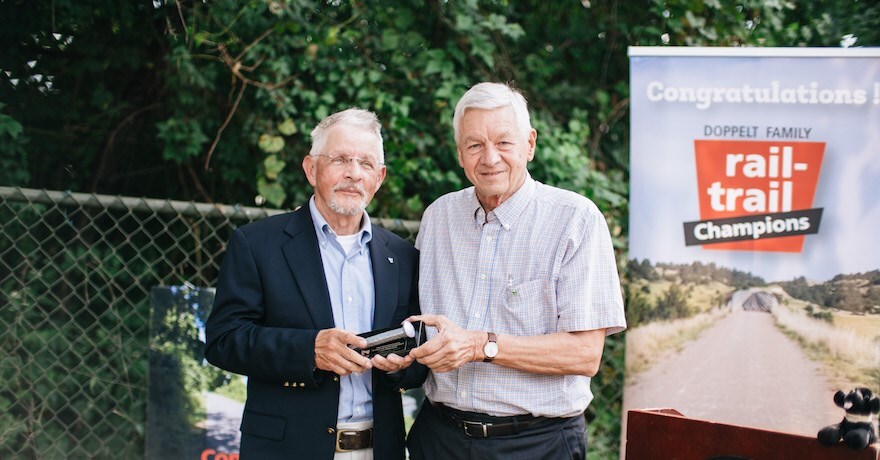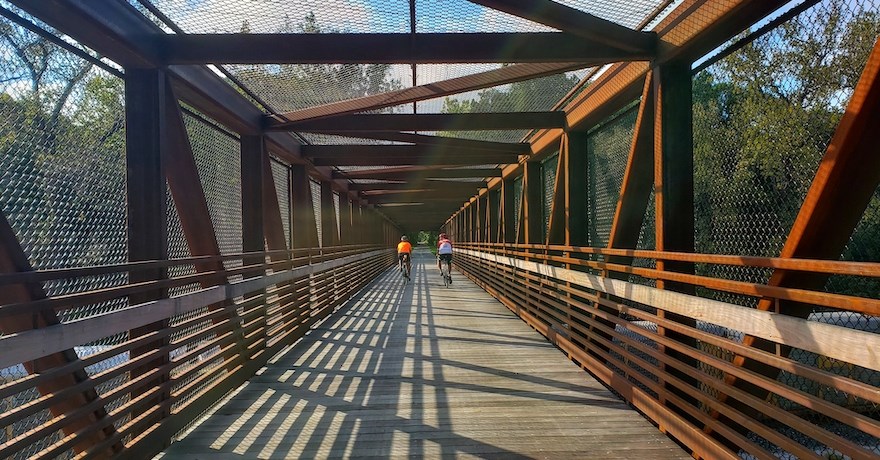Rails to Trails Landowner Rights Act Fact Sheet and RTC Sign-On Letter

RTC’s Railbanking Sign-On Letter in opposition to H.R. 4924, the Rails to Trails Landowner Rights Act
Rails to Trails Conservancy recently led a national sign-on letter in opposition to H.R. 4924, the “Rails to Trails Landowner Rights Act,” legislation that poses an existential threat to America’s rail-trails. The letter to the leadership of the House Committee on Natural Resources was signed by over a dozen national organizations and describes the numerous ways in which this anti-railbanking legislation threatens existing and future rail-trails and the communities they benefit. The letter outlines how the railbanking statute, enacted in 1983, preserves critical railroad corridors that connect people to daily destinations, enabling communities to experience the economic, health, safety and quality-of-life benefits trails deliver, while also preserving corridors for future rail service. You can view and download the letter below.
What Is Railbanking?
Railbanking, established in 1983 as an amendment to the National Trails System Act, is a popular and effective tool to preserve unused rail corridors for future transportation needs while allowing interim use as recreational trails. Through this innovative statute, Congress has safeguarded a tremendous national asset: America’s rail corridors, ensuring that they remain available for potential rail reactivation while providing communities with trails for walking, biking and being active outside. Today, there are thousands of miles of railbanked corridors traversing 162 Congressional districts spanning 43 states and Washington, D.C., and more than 9,000 miles of future rail-trail ready to be developed—delivering an essential resource for quality of life, transportation and economic development.
When a corridor is railbanked, a “trail sponsor,” such as a local government, negotiates with the railroad to acquire the right of way and works with residents to design and build the trail. Through railbanking, corridors are preserved by the federal government, which is responsible for compensating landowners if a legal property interest has been taken. Over more than four decades, railbanking has been upheld by the Supreme Court and is widely used by rural, urban, and suburban communities to keep unused rail corridors intact while providing an essential service to people and places nationwide.

Key Features of Railbanking
- Interim Trail Use: The corridor is converted into a public-use trail, providing community benefits while maintaining the corridor’s structural integrity should it be reactivated in the future for rail service.
- Voluntary Agreements: Railbanking occurs through mutual consent between the railroad owner and a trail sponsor, such as a government agency or nonprofit organization.
- Preservation of Corridors: Railbanking protects rail corridors, preventing them from being dismantled or sold in fragments, ensuring they remain viable for future rail and transportation projects.
Benefits of Railbanking
- Future Rail Conservation: Rail corridors remain intact, preserving the right and opportunity to reinstate rail service, creating efficiency and saving costs.
- Community Enhancement: Trails improve quality of life, promote mobility and recreation, and create economic opportunities through tourism and local business growth.
- Environmental Protection: Preserved corridors foster biodiversity, conserve green spaces, and mitigate urban sprawl.
- Public Health Benefits: Trails promote physical activity and provide safe transportation alternatives.
How the “Rails to Trails” Landowner Rights Act” (H.R. 4924) Threatens Railbanking
The “Rails to Trails Landowner Rights Act” (H.R.4924) effectively destroys the viability of railbanking, undercutting the law at the foundation of the nation’s decades-long movement to preserve unused railroad corridors as multiuse trails. The bill is an unconstitutional attack on railbanking, violating Fifth Amendment rights, masquerading as a series of process improvements that are anything but. It introduces exceedingly burdensome and unworkable changes to railbanking, outlined below, that threaten future and existing rail-trails and risk causing irreparable harm to the nation’s rail corridors.
- The bill would unconstitutionally shift financial liability from the federal government to trail sponsors, most often local governments, to compensate adjacent landowners for all “costs” claimed to be associated with trail use, regardless of whether there is a property interest justifying compensation.
- Trail sponsor must obtain, within 30 days of filing a statement of willingness to railbank, signed written approval of every adjacent landowner as a condition of railbanking. Lack of affirmative consent from even a single landowner would preclude railbanking, leaving these corridors irreparably fragmented or lost.
- Trail sponsors must assume lifetime responsibility for maintaining the corridor until it is reactivated for rail service, creating long-term liabilities even for short-term trail sponsors, discouraging anyone from stepping in to save a corridor pending identification of a permanent trail sponsor.The trail sponsor will be required to conduct and pay for unnecessary cost-benefit analysis addressing impacts on security, bio security, food security, and other irrelevant issues. This and other new, unnecessary administrative requirements could delay the railbanking process and add greater expense, discouraging trail sponsors like local governments from protecting rail corridors.
- The Surface Transportation Board (STB) will be required to review all existing railbanked corridors then provide recommendations to Congress for maintenance requirements of trail sponsors, which could encourage unnecessary and impractical federal control of local roles, and consider requests to narrow the width of corridors to match future railroad needs, but such needs are not known prior to reinstatement of rail service.
These draconian changes exceed the capacity of the STB to manage and will result in lost opportunities to invest in America’s rural areas and cities, alongside the loss of transportation corridors, green spaces, historic sites and public trails that provide invaluable quality of life and economic development opportunities for communities nationwide.
Read the full text of the bill.


Donate
Everyone deserves access to safe ways to walk, bike, and be active outdoors.